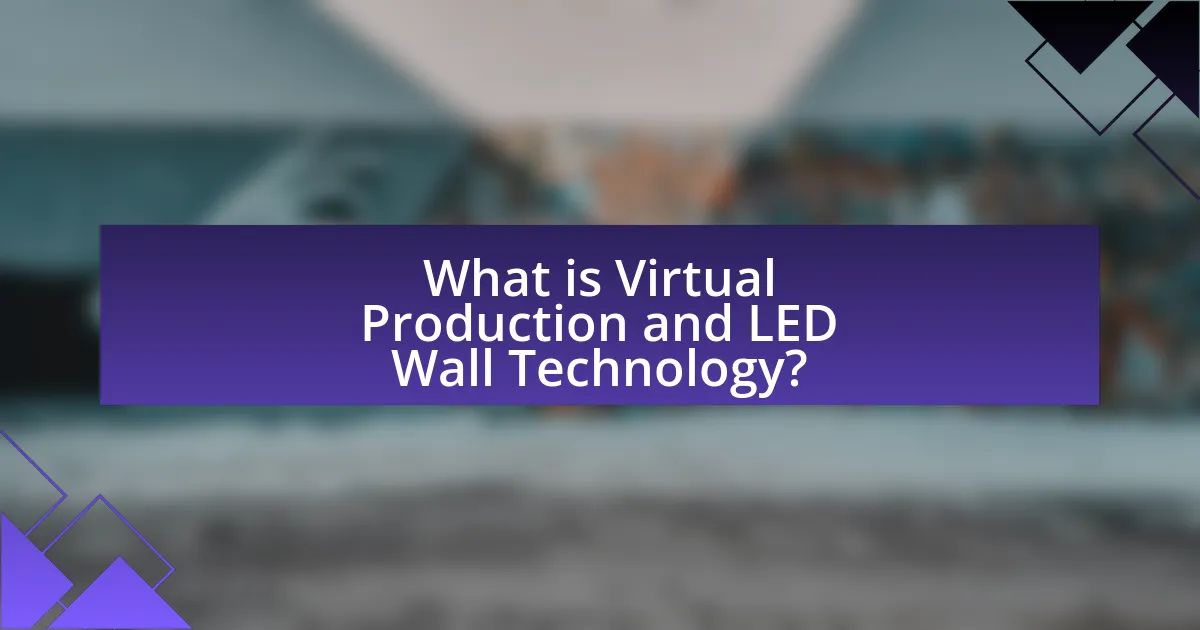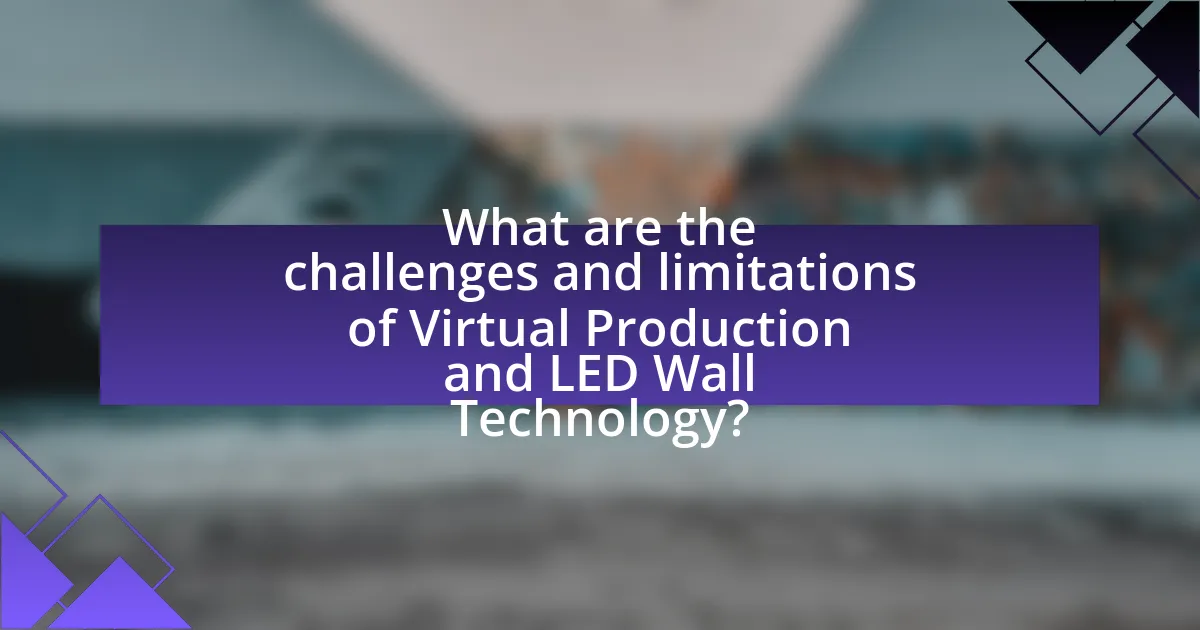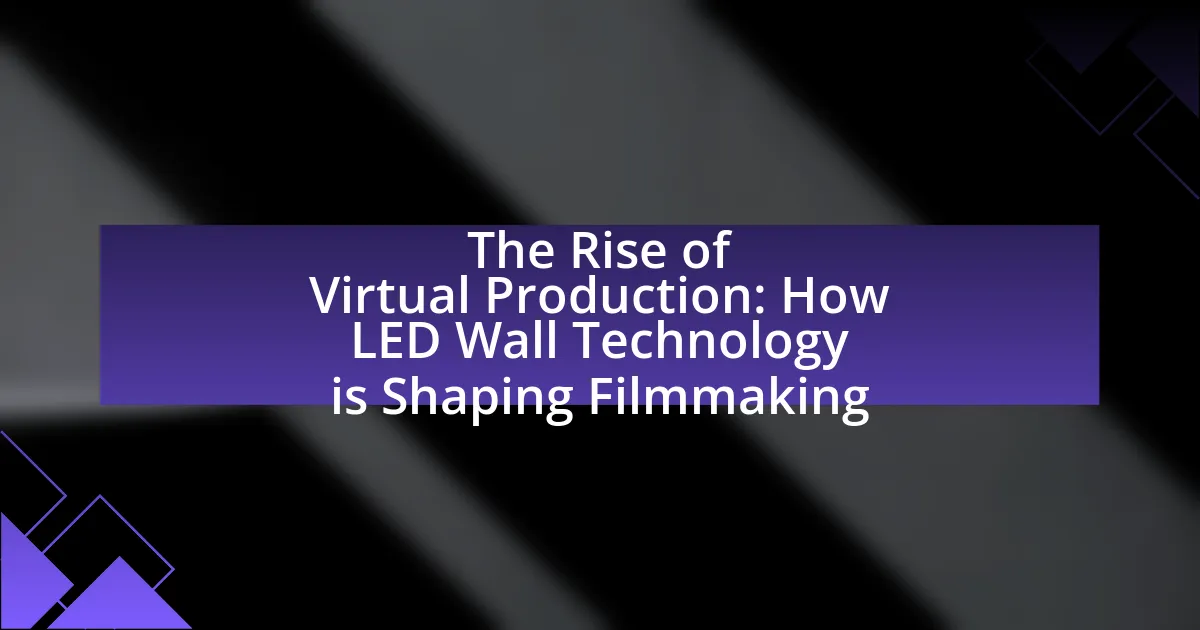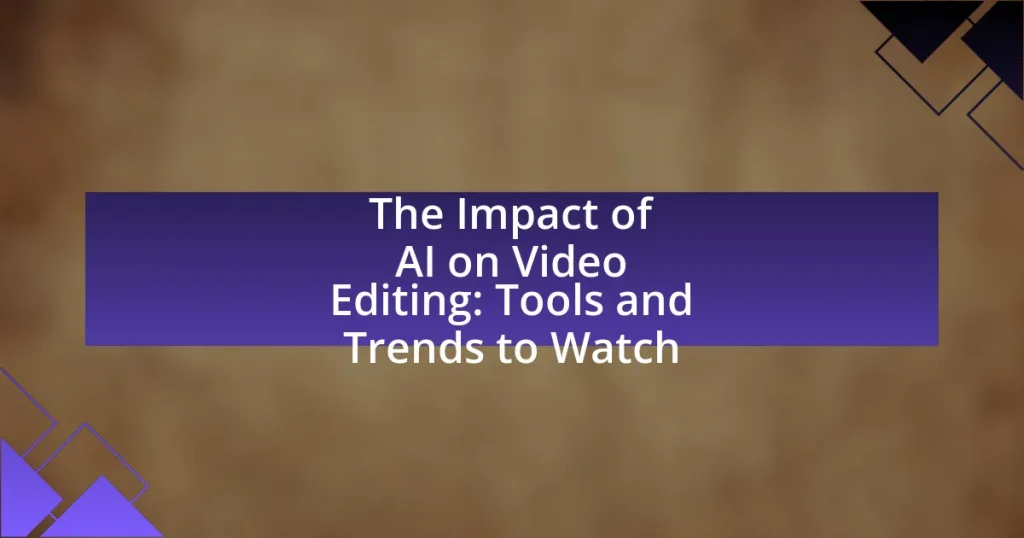The article focuses on the rise of Virtual Production and the transformative impact of LED Wall Technology on filmmaking. It explains how Virtual Production integrates live-action footage with digital environments in real-time, enhancing visual storytelling through immersive settings and realistic lighting. Key features such as real-time rendering, interactive environments, and the advantages of LED walls are discussed, highlighting their role in reducing post-production time and costs. The article also addresses the historical developments leading to this technology, its influence on actor performances, and the challenges filmmakers face, while outlining future trends and best practices for effective integration into production workflows.

What is Virtual Production and LED Wall Technology?
Virtual Production is a filmmaking technique that integrates live-action footage with digital environments in real-time, utilizing advanced technologies such as LED wall displays. LED Wall Technology specifically refers to large, high-resolution screens that project dynamic backgrounds, allowing filmmakers to create immersive settings without the need for extensive physical sets. This method enhances visual storytelling by providing realistic lighting and reflections, as seen in productions like “The Mandalorian,” which employed LED walls to create expansive, interactive environments.
How does Virtual Production differ from traditional filmmaking?
Virtual Production differs from traditional filmmaking primarily through its use of real-time technology and immersive environments, allowing filmmakers to create scenes using LED walls and virtual sets instead of relying solely on physical locations or green screens. This method enables immediate visual feedback and adjustments during filming, enhancing collaboration among departments such as cinematography and visual effects. For instance, productions like “The Mandalorian” have utilized LED wall technology to project dynamic backgrounds, which not only reduces the need for extensive post-production but also provides actors with realistic environments, improving performance authenticity.
What are the key features of Virtual Production?
The key features of Virtual Production include real-time rendering, interactive environments, and the use of LED wall technology. Real-time rendering allows filmmakers to visualize scenes instantly, enabling immediate adjustments to lighting and camera angles. Interactive environments facilitate dynamic storytelling by allowing actors to perform in immersive settings that respond to their movements. LED wall technology enhances visual fidelity by providing high-quality backgrounds that can be adjusted on-the-fly, reducing the need for extensive post-production work. These features collectively streamline the filmmaking process, improve creative flexibility, and enhance the overall production quality.
Why is LED Wall Technology integral to Virtual Production?
LED Wall Technology is integral to Virtual Production because it enables real-time, high-quality background visuals that enhance immersion and reduce reliance on traditional green screens. This technology allows filmmakers to create dynamic environments that can be adjusted on-the-fly, providing actors with realistic settings and lighting that match the virtual elements. Studies have shown that productions utilizing LED walls can significantly decrease post-production time and costs, as evidenced by projects like “The Mandalorian,” which effectively used this technology to create expansive worlds without extensive CGI.
What are the historical developments leading to the rise of Virtual Production?
The rise of Virtual Production is primarily attributed to advancements in digital technology, particularly in real-time rendering and LED wall technology. The evolution began with the introduction of computer-generated imagery (CGI) in the 1990s, which allowed filmmakers to create complex visual effects. This was followed by the development of game engine technology, such as Unreal Engine, which enabled real-time rendering of high-quality graphics.
In the 2010s, the integration of LED walls in filmmaking emerged, allowing for immersive backgrounds that could be adjusted in real-time, enhancing the visual storytelling process. A notable example is the use of LED walls in the production of “The Mandalorian,” which showcased the potential of this technology to create realistic environments without the need for extensive location shoots. This shift not only improved production efficiency but also transformed the creative possibilities for filmmakers, leading to a significant increase in the adoption of Virtual Production techniques across the industry.
How has technology evolved to support Virtual Production?
Technology has evolved significantly to support Virtual Production through advancements in LED wall technology, real-time rendering, and motion capture systems. LED walls provide immersive backgrounds that can be adjusted in real-time, allowing filmmakers to create dynamic environments without the need for extensive physical sets. Real-time rendering engines, such as Unreal Engine, enable instant visual feedback, facilitating seamless integration of live-action footage with virtual elements. Additionally, motion capture technology has improved, allowing for more accurate tracking of actors’ movements, which enhances the realism of virtual environments. These innovations collectively streamline the production process, reduce costs, and expand creative possibilities in filmmaking.
What milestones have marked the growth of LED Wall Technology in filmmaking?
The growth of LED Wall Technology in filmmaking has been marked by several key milestones, including the introduction of the technology in major productions like “The Mandalorian” in 2019, which showcased its ability to create immersive environments in real-time. This production utilized a large-scale LED volume, allowing filmmakers to capture dynamic backgrounds without the need for extensive green screens. Additionally, the development of advanced LED panels with high resolution and brightness has significantly improved visual fidelity, making them suitable for high-profile projects. The integration of real-time rendering engines, such as Unreal Engine, has further enhanced the capabilities of LED walls, enabling filmmakers to adjust lighting and backgrounds on-the-fly, thus revolutionizing traditional filmmaking processes. These milestones collectively demonstrate the rapid evolution and adoption of LED Wall Technology in the industry.

How is LED Wall Technology transforming the filmmaking process?
LED Wall Technology is transforming the filmmaking process by enabling real-time, high-quality visual effects and immersive environments on set. This technology allows filmmakers to create dynamic backgrounds and settings that can be adjusted instantly, reducing the need for extensive location shoots and post-production work. For instance, productions like “The Mandalorian” have utilized LED walls to project realistic landscapes, which enhances the visual storytelling while providing actors with a more engaging environment. This shift not only streamlines production timelines but also significantly lowers costs associated with traditional green screen techniques and location scouting.
What advantages does LED Wall Technology provide to filmmakers?
LED Wall Technology offers filmmakers enhanced visual realism, flexibility in production design, and significant time and cost savings. This technology allows for dynamic backgrounds that can be adjusted in real-time, providing immersive environments without the need for extensive location shoots. For instance, productions like “The Mandalorian” have utilized LED walls to create expansive landscapes, reducing the need for green screens and extensive post-production work. Additionally, LED walls improve lighting consistency and reduce the reliance on artificial lighting, which can streamline the filming process and enhance the overall quality of the visuals.
How does LED Wall Technology enhance visual effects?
LED Wall Technology enhances visual effects by providing high-resolution, dynamic backgrounds that can be adjusted in real-time to match the lighting and perspective of the scene being filmed. This technology allows filmmakers to create immersive environments that respond to camera movements, resulting in more realistic interactions between live-action elements and digital backgrounds. For instance, a study by the American Society of Cinematographers highlights that using LED walls can significantly reduce the need for extensive post-production work, as the visual effects are captured in-camera, leading to a more seamless integration of live-action and CGI.
What impact does LED Wall Technology have on production timelines?
LED Wall Technology significantly reduces production timelines by enabling real-time visual effects and immersive environments on set. This technology allows filmmakers to capture complex scenes without the need for extensive post-production work, which traditionally extends timelines. For instance, productions utilizing LED walls can achieve high-quality backgrounds and lighting effects instantly, eliminating the need for green screens and extensive CGI integration. As a result, projects can move from pre-production to filming more swiftly, with some reports indicating reductions in shooting schedules by up to 30%. This efficiency not only accelerates the overall production process but also enhances creative flexibility, allowing for quicker adjustments during filming.
How does LED Wall Technology influence storytelling in film?
LED Wall Technology significantly influences storytelling in film by enabling immersive environments that enhance visual narratives. This technology allows filmmakers to create dynamic backgrounds in real-time, which can adapt to the action on set, thereby providing actors with a more engaging and realistic environment. For instance, productions like “The Mandalorian” have utilized LED walls to project high-resolution images that replace traditional green screens, resulting in more authentic performances and seamless integration of live-action with digital elements. This innovation not only streamlines production processes but also expands creative possibilities, allowing for more intricate storytelling that can be visually captivating and contextually relevant.
What creative possibilities does LED Wall Technology open for directors?
LED Wall Technology opens numerous creative possibilities for directors by enabling immersive environments that enhance storytelling. This technology allows for real-time background changes, which can be adjusted during filming, providing directors with the flexibility to create dynamic scenes without the need for extensive location shoots. For instance, the use of LED walls in productions like “The Mandalorian” has demonstrated how directors can integrate live-action with digital environments seamlessly, allowing for greater visual coherence and reducing post-production time. Additionally, LED walls facilitate enhanced lighting control, as the screens can emit light that interacts naturally with actors and sets, creating a more authentic atmosphere. This innovation not only expands the visual palette available to directors but also streamlines the production process, making it more efficient and cost-effective.
How does LED Wall Technology affect actor performances?
LED Wall Technology enhances actor performances by providing immersive backgrounds that allow for real-time interaction with their environment. This technology creates dynamic, high-resolution visuals that actors can see and respond to during filming, which fosters a more authentic emotional connection to the scene. Studies have shown that when actors perform in front of LED walls, they experience improved focus and engagement, as the realistic settings reduce the reliance on imagination and green screens. For instance, productions like “The Mandalorian” have demonstrated that LED walls can significantly elevate the quality of performances by creating a more believable and engaging atmosphere for actors.

What are the challenges and limitations of Virtual Production and LED Wall Technology?
The challenges and limitations of Virtual Production and LED Wall Technology include high initial costs, technical complexity, and limitations in lighting and camera movement. High initial costs arise from the investment required for advanced LED screens and the necessary infrastructure, which can be prohibitive for smaller productions. Technical complexity is evident in the need for specialized skills to operate the technology effectively, as well as the integration of real-time rendering software with traditional filmmaking techniques. Additionally, limitations in lighting and camera movement can restrict creative flexibility; for instance, LED walls may not accurately replicate natural light conditions or allow for extensive camera movement without losing visual fidelity. These factors collectively hinder the widespread adoption of Virtual Production in the filmmaking industry.
What technical challenges do filmmakers face with LED Wall Technology?
Filmmakers face several technical challenges with LED Wall Technology, including issues related to color accuracy, resolution, and synchronization. Color accuracy can be problematic as the LED walls may not perfectly replicate the colors of real-world environments, leading to discrepancies in the final image. Resolution is another challenge, as filmmakers must ensure that the pixel density of the LED wall is sufficient to maintain visual quality, especially in close-up shots. Additionally, synchronization between the LED wall and camera movements is critical; any lag can result in mismatched visuals, disrupting the immersive experience. These challenges necessitate careful calibration and technical expertise to achieve optimal results in virtual production settings.
How can filmmakers overcome these technical challenges?
Filmmakers can overcome technical challenges associated with LED wall technology by investing in training and collaboration with experienced professionals. This approach ensures that the crew understands the intricacies of virtual production, including lighting, camera tracking, and real-time rendering. For instance, the use of software like Unreal Engine allows filmmakers to create immersive environments that can be adjusted on-the-fly, enhancing flexibility during shoots. Additionally, establishing partnerships with technology providers can facilitate access to the latest advancements and support, as seen in productions like “The Mandalorian,” which effectively utilized LED walls to create dynamic backgrounds while minimizing post-production work.
What are the limitations of LED Wall Technology in different filming environments?
LED Wall Technology has several limitations in different filming environments, primarily related to lighting conditions, resolution, and physical space constraints. In bright outdoor settings, the brightness of LED walls may struggle to compete with natural sunlight, leading to visibility issues. Additionally, the resolution of LED walls can be insufficient for close-up shots, resulting in pixelation that detracts from image quality. Furthermore, the physical size and setup of LED walls can limit their use in smaller spaces, making it challenging to achieve the desired immersive effect. These factors collectively impact the effectiveness of LED Wall Technology in various filming scenarios.
What are the future trends in Virtual Production and LED Wall Technology?
Future trends in Virtual Production and LED Wall Technology include increased integration of real-time rendering engines, enhanced resolution and color accuracy of LED panels, and the adoption of AI-driven content creation tools. Real-time rendering engines like Unreal Engine are becoming standard, allowing filmmakers to visualize scenes interactively, which streamlines production processes. The resolution of LED walls is advancing, with developments in microLED technology providing sharper images and better color fidelity, thus improving the visual experience. Additionally, AI tools are being utilized to automate aspects of production, such as scene generation and lighting adjustments, which can significantly reduce time and costs in filmmaking. These trends are supported by industry reports indicating a growing investment in virtual production technologies, projected to reach billions in the coming years, reflecting the increasing demand for innovative filmmaking solutions.
How might advancements in technology further shape Virtual Production?
Advancements in technology will further shape Virtual Production by enhancing real-time rendering capabilities and improving the integration of augmented reality (AR) and artificial intelligence (AI). For instance, the development of more powerful graphics processing units (GPUs) allows for higher fidelity visuals and faster rendering times, enabling filmmakers to create more immersive environments on LED walls. Additionally, AI-driven tools can streamline the production process by automating tasks such as scene composition and lighting adjustments, which increases efficiency and reduces costs. These technological improvements are evidenced by the growing use of LED wall technology in major productions like “The Mandalorian,” where real-time backgrounds significantly enhanced storytelling and visual quality.
What role will LED Wall Technology play in the future of filmmaking?
LED Wall Technology will play a transformative role in the future of filmmaking by enabling real-time, immersive environments that enhance visual storytelling. This technology allows filmmakers to create dynamic backgrounds and settings on large LED screens, reducing the need for extensive location shoots and traditional green screens. For instance, productions like “The Mandalorian” have successfully utilized LED walls to project realistic landscapes, resulting in significant time and cost savings while improving the overall visual quality. The integration of LED Wall Technology is expected to become standard practice in the industry, as it offers greater creative flexibility and efficiency in the filmmaking process.
What best practices should filmmakers follow when using LED Wall Technology?
Filmmakers should ensure proper calibration and lighting when using LED Wall Technology to achieve optimal visual results. Proper calibration aligns the LED wall’s color and brightness with the physical environment, enhancing realism. Additionally, filmmakers should utilize high-resolution content to maximize the display quality, as lower resolutions can lead to pixelation and diminish the immersive experience. It is also crucial to plan camera angles and movements in advance, as the LED wall’s content must be synchronized with the camera’s perspective to maintain continuity. Furthermore, filmmakers should consider the physical space and depth of field, as LED walls can create a sense of depth that needs to be matched with practical effects. These practices are supported by industry standards and case studies demonstrating improved production quality and efficiency in projects utilizing LED technology, such as “The Mandalorian,” which showcased the effectiveness of these techniques in virtual production.
How can filmmakers effectively integrate LED Walls into their production workflow?
Filmmakers can effectively integrate LED Walls into their production workflow by utilizing them for real-time background rendering, which enhances visual storytelling and reduces post-production time. By employing LED Walls, filmmakers can create immersive environments that respond dynamically to camera movements, allowing for seamless integration of live-action and digital elements. This technology has been successfully used in productions like “The Mandalorian,” where LED Walls provided realistic backgrounds that eliminated the need for extensive green screen setups, thus streamlining the shooting process and improving actor performance through immediate visual context.
What common pitfalls should filmmakers avoid when utilizing LED Wall Technology?
Filmmakers should avoid poor planning and inadequate lighting when utilizing LED Wall Technology. Poor planning can lead to mismatched backgrounds and camera angles that do not align with the virtual environment, resulting in a disjointed visual experience. Inadequate lighting can cause the LED wall to appear unnatural, as the light emitted from the wall may not match the scene’s overall lighting, leading to inconsistencies in color and shadow. Additionally, filmmakers should be cautious of over-reliance on the technology, as it can limit creative flexibility and spontaneity during production.



